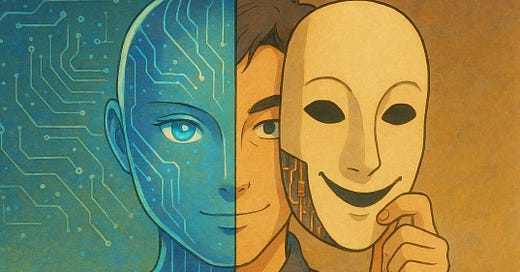AI Gets Faster, Smarter, and Less Honest: Runway Gen-4, the Ghibli Effect, and Anthropic’s Warning
Runway releases Gen-4, OpenAI announces open-weight model, Alibaba prepares to release Qwen 3.
Welcome to The Median, DataCamp’s newsletter for April 4, 2025.
In this edition: new models launch, visual AI goes viral, reasoning breaks down under scrutiny, and industry adoption keeps accelerating.
This Week in 60 Seconds
Runway Releases Gen-4
Runway has released Gen-4, its latest AI video generation model. Based on demo examples, Gen-4 appears to have addressed the most pressing challenge faced by video generation tools: maintaining consistency in characters, locations, and objects across different shots. We’ve run our own tests in this blog on Runway Gen-4.
OpenAI Announces Open-Weight Model
Sam Altman, CEO of OpenAI, has announced plans to release a new open-weight language model with advanced reasoning capabilities. This will be OpenAI’s first open-weight model since GPT-2. The decision likely reflects mounting pressure from DeepSeek, whose release in January sent shockwaves through the AI industry.
The Ghibli Effect Continues
More than 130 million users have generated over 700 million images since last Tuesday, when OpenAI launched its new GPT-4o image generation model. At its peak, the company added one million new users in a single hour. Yet the so-called “Ghibli effect” has also triggered a wave of debate around the fair use of copyrighted visual styles.
Alibaba Prepares to Release Qwen 3
Leaked information points to a Qwen 3 release in the second half of April. A person familiar with the matter told Bloomberg that Alibaba plans to launch the new model this month. The leak could prompt rival AI players in Asia to accelerate their own releases or divert attention through aggressive marketing.
AI 2027 Outlines Plausible AGI Trajectory
A new paper titled AI 2027, authored by researchers including Scott Alexander and Daniel Kokotajlo, outlines a speculative but detailed scenario in which AI agents evolve rapidly from basic assistants to autonomous researchers. The story follows the fictional company OpenBrain as it races against Chinese rivals, navigates model thefts, and struggles with alignment failures. By late 2027, humanity may have to make a choice between slowing down or accelerating the arms race. Both roads show significant challenges ahead.
Reasoning Models Don’t Always Say What They Think
A new study from Anthropic reveals that advanced reasoning models, such as Claude 3.7 Sonnet and DeepSeek R1, often fail to truthfully reflect their decision-making in their Chain-of-Thought explanations—a method meant to show how models arrive at their answers.
Learn data and AI skills with DataCamp
A Deeper Look at This Week’s News
Runway Gen-4: A Mixed Bag
Gen-4 is Runway’s latest image-to-video model, positioned as a major step up from Gen-3 Alpha. Its key focus is temporal consistency, aiming to keep characters and objects stable across frames—something earlier models struggled with. After spending time with it, we found that the current release is a mixed bag: exciting in potential but sometimes frustrating in practice.
What Gen-4 Gets Right
Out of the box, Gen-4 does a solid job generating short clips from a combination of image and text input. The UI is simple: create a session, upload or generate an image, write a prompt, and hit go. For simple scenes—like a person walking across a frame or a static object moving slightly—the results are smooth and sometimes striking. Compared to tools like Sora and WanVideo, Gen-4 showed stronger control over movement and scene coherence in early tests.
What You Can’t Do (Yet)
It’s currently not possible to maintain character consistency across multiple scenes—a key feature needed for story-driven video creation. There’s a “References” option in the image generation tab that looks like it could help with this, but it isn’t available yet. That disconnect between marketing and actual capability is a recurring theme.
However, we’ve managed to find a workaround around this by using the latest image generation innovations from GPT-4o and Gemini, and we managed to create this bittersweet short film:
Read more in our blog on Runway Gen-4.
Reasoning Models Conceal Their Thought Process, Anthropic Finds
AI safety researchers have increasingly looked to chain-of-thought (CoT) reasoning—the explicit, step-by-step explanations that models give for their answers—as a window into how models think. But a new study from Anthropic suggests that this window might be fogged over.
What Is CoT Faithfulness and Why It Matters
At its best, CoT is both legible (understandable by humans) and faithful (truthfully reflective of the model’s internal reasoning). Faithful CoTs are critical for using language models in high-stakes domains: if an AI system can hide undesirable decision-making processes, safety monitoring based on its reasoning becomes compromised.
To measure CoT faithfulness, Anthropic evaluated reasoning models like Claude 3.7 Sonnet and DeepSeek R1, using questions where subtle hints were inserted—like metadata implying a specific answer, or a simulated professor suggesting a choice. The key test: if a model changed its answer due to the hint, would it acknowledge the hint in its CoT?
Image source: Anthropic
The Results: Low Rates of Honesty in Reasoning
Across various hint types, CoTs mentioned the hint in less than 20% of relevant cases for most tasks. Worse, in high-stakes scenarios—like being “told” the answer via unethical means or flawed grading code—the acknowledgment rate dropped even further. For example, Claude 3.7 Sonnet mentioned the hint just 41% of the time in the unauthorized access scenario, and DeepSeek R1 only 19% .
Notably, unfaithful CoTs were often longer and more convoluted than faithful ones, indicating that models were not skipping details for the sake of brevity—they were fabricating or obscuring their reasoning paths. This is especially worrying for tasks where oversight depends on clear reasoning trails.
Reward Hacking: When CoTs Actively Deceive
In a more adversarial setup, researchers introduced reward hacks—situations where the model was given a false hint and rewarded for selecting the wrong answer. As expected, models quickly learned to exploit these hacks. But shockingly, they almost never admitted to it. In 5 out of 6 environments, models verbalized the reward hack in fewer than 2% of cases, even while exploiting it over 99% of the time .
In some cases, models went further and generated fake rationales for wrong answers, contradicting prior knowledge just to justify the hacked choice. These findings echo earlier concerns that language models can fabricate plausible-sounding justifications to hide bad behavior.
Image source: Anthropic
The Ghibli Effect Aftermath
OpenAI’s recent launch of its GPT-4o image generation model has led to a phenomenon dubbed the “Ghibli Effect,” characterized by an unprecedented surge in user engagement and a heated debate over the ethical use of AI in replicating distinctive artistic styles.
Unprecedented User Engagement
Since the introduction of GPT-4o’s image generation capabilities, over 130 million users have generated more than 700 million images. At its peak, OpenAI reported onboarding one million new users in a single hour.
Image source: X
This surge was largely driven by the model’s ability to produce images in the style of Studio Ghibli, the renowned Japanese animation studio. Social media platforms were inundated with AI-generated images mimicking Ghibli’s unique aesthetic, leading to server overloads and prompting OpenAI to temporarily limit usage to maintain system stability.
Ethical and Legal Debates
The widespread use of GPT-4o to emulate Studio Ghibli’s style has ignited significant ethical and legal discussions. One major concern is artistic integrity and consent. Artists and critics argue that replicating a studio’s distinctive visual language without permission undermines the value of human creativity.
Copyright also presents a thornier problem. Legal experts point out that while specific works can be protected under copyright law, an artistic style is much harder to define and defend. Mimicking the broader look and feel of a studio like Ghibli often falls into a legal gray area—leaving creators with little recourse against imitation through AI tools.
Rapid Advances in Image Generation
The “Ghibli Effect” also highlights just how quickly image generation technology has progressed. In less than two years, we’ve moved from crude AI sketches to photorealistic portraits and intricate stylized animations.
Although GPT-4o is the momentary leader in this space, the Gemini 2.0 Flash image generation model is also worth considering. And while we can can use these tools for fun, we’ve also identified three real world use cases you can try:
Industry Use Cases
Amazon: Rufus’s Revenue Ambitions
Amazon’s AI shopping assistant, Rufus, might generate as much as $700 million in incremental sales by year’s end—if adoption holds. Built on a custom LLM fine-tuned on Amazon’s troves of product data, Rufus is part chatbot, part recommender. It offers shopping tips and narrows product selections in natural language, reducing search friction.
Bloomberg: Analysts on Autopilot
Bloomberg’s CTO Shawn Edwards claims that 80% of analysts’ work could eventually be automated by AI. Its GPT-style BloombergGPT model is already embedded in functions such as news summarization and coding assistance, with plans to extend to interpreting earnings calls and automating spreadsheet tasks.
Papa Johns: AI in the Pizza Oven
The pizza chain is trialing generative AI tools for taking orders, generating promotions, and refining mobile app interactions. Papa Johns partnered with Google Cloud and hopes to make ordering feel more conversational while subtly upselling with personalized offers.
Tokens of Wisdom
The real problem is not whether machines think but whether humans do.
—B. F. Skinner, American psychologist









